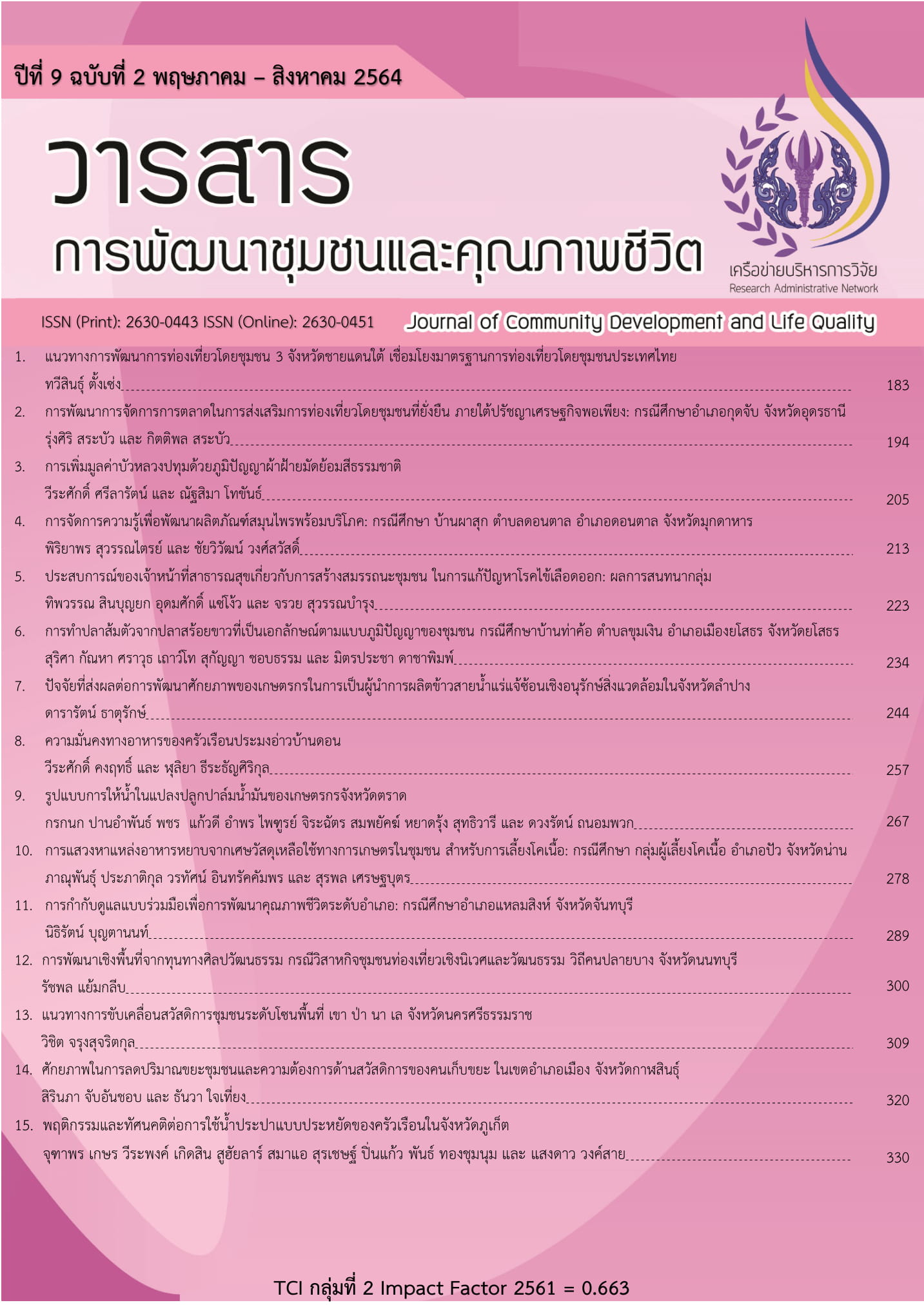แนวทางการพัฒนาการท่องเที่ยวโดยชุมชน 3 จังหวัดชายแดนใต้ เชื่อมโยงมาตรฐานการท่องเที่ยวโดยชุมชนประเทศไทย
Main Article Content
บทคัดย่อ
การศึกษาและการวิจัยมีวัตถุประสงค์เพื่อนำเสนอแนวทางการเสริมสร้างศักยภาพการท่องเที่ยวโดยชุมชนเพื่อยกระดับเศรษฐกิจฐานราก 3 จังหวัดชายแดนใต้ เป็นวิจัยแบบผสมผสาน มีกลุ่มตัวอย่างประกอบด้วยตัวแทนหน่วยงานภาครัฐและเอกชน ชาวบ้านและแกนนำชุมชน โดยมีเครื่องมือในการเก็บรวบรวมข้อมูลประกอบด้วย เกณฑ์มาตรฐานการท่องเที่ยวโดยชุมชนประเทศไทย และแบบสัมภาษณ์ และดำเนินการวิเคราะห์ข้อมูลด้วยการวิเคราะห์เนื้อหา และสถิติเชิงพรรณนา ได้แก่ ร้อยละ ค่าเฉลี่ย และส่วนเบี่ยงเบนมาตรฐาน
ผลการศึกษาพบว่า แนวทางการบริหารจัดการสามารถเชื่อมโยงมาตรฐานการท่องเที่ยวโดยชุมชนประเทศไทย เป็นการสร้างเศรษฐกิจฐานรากให้กับพื้นที่ 3 จังหวัดชายแดนใต้ ภายใต้ความเชื่อมโยงของการพัฒนาคน การพัฒนาแหล่งท่องเที่ยว และการบริหารจัดการกลุ่ม โดยเริ่มจากการพัฒนาศักยภาพให้กับสมาชิกในชุมชน จากนั้นดำเนินการพัฒนาแหล่งท่องเที่ยวให้มีความหลากหลายภายใต้อัตลักษณ์ของทรัพยากรชุมชน ถัดไปชุมชนจะต้องดำเนินสร้างระเบียบและการบริหารจัดการที่มีประสิทธิภาพเพราะส่งผลต่อความยั่งยืน และการสร้างมูลค่าเพิ่มจากการท่องเที่ยวด้วยการยกระดับการให้บริการ และดำเนินงานอย่างต่อเนื่อง
Article Details
กองบรรณาธิการขอสงวนสิทธิ์ในการตรวจและแก้ไขบทความที่เสนอเพื่อตีพิมพ์ในวารสารการพัฒนาชุมชนและคุณภาพชีวิต
บทความหรือข้อความคิดเห็นใด ๆ ที่ปรากฏในวารสารการพัฒนาชุมชนและคุณภาพชีวิต เป็นวรรณกรรมของผู้เขียนโดยเฉพาะคณะผู้จัดทำไม่จำเป็นต้องเห็นด้วย และไม่ใช่ความรับผิดชอบของมหาวิทยาลัยและคณะผู้จัดทำ / บรรณาธิการ
เอกสารอ้างอิง
Amerta, I.M. 2017. Community based tourism development. International Journal of Social Sciences and Humanities 1(3): 97-107.
Asli, D.A., K.J. Semrad and S.S. Yilmaz. 2013. Community based tourism finding the equilibrium in COMCEC context setting the pathway for the future. COMCEC Coordination Office Ankara.
Buakwan, N. and P. Chaiyakot. 2014. Research program for development of standards suitable for tourism by communities in the 5 southern border provinces to ASEAN. The Thailand Research Fund, Bankok. (in Thai)
Chaiyakot, P. and N. Buakwan. 2018.A complete research report on the study of tourism products composition of tourism by communities in 5 southern border provinces (Satun, Songkhla, Pattani, Yala, and Narathiwat). The Thailand Research Fund, Bankok. (in Thai)
Designated Areas for Sustainable Tourism. 2017. Tourist statistics for 2016. (Online). Available: http://www.dasta.or.th (August 14, 2019). (in Thai)
Giampiccoli, A. and M. Saayman. 2018. Community-based tourism development model and community participation. African Journal of Hospitality, Tourism and Leisure 7(4): 1-27.
Global Sustainable Tourism Council. 2012. Global sustainable tourism destination criteria. (Online). Available: http://www. gstcouncil.org (August 14, 2019).
Hamzah, A. and Z. Khalifah. 2009. Handbook on community based tourism: How to develop and sustain CBT. APEC. Secretariat, Kuala Lumpur.
Jugmohan, S. and A. Giampiccoli. 2017. Community-based tourism development: A possible educational gap. Anthropologist 30(1): 52-60.
Lee, T.H. 2019. Can community-based tourism contribute to sustainable development? evidence from residents’ perceptions of the sustainability. Tourism Management 70: 368-380.
Lopez-Guzman, T., S. Sanchez and V. Pavón. 2011. Community-based tourism in developing countries: A case study. TOURISMOS: An International Multidisciplinary Refereed Journal of Tourism 6(1): 69-84.
Ministry of Tourism and Sports. 2017. Tourist statistics for 2016. (Online). Available: http://www.mots.go.th (August 14, 2019). (in Thai)
Suansri, P. 2011. CBT has a social space dimension of the community in determining tourism directions, Creating learning between the host and visitors. Best Practice 5 Case studies nationwide. Bangkok: Wanida Printing. Bangkok.


